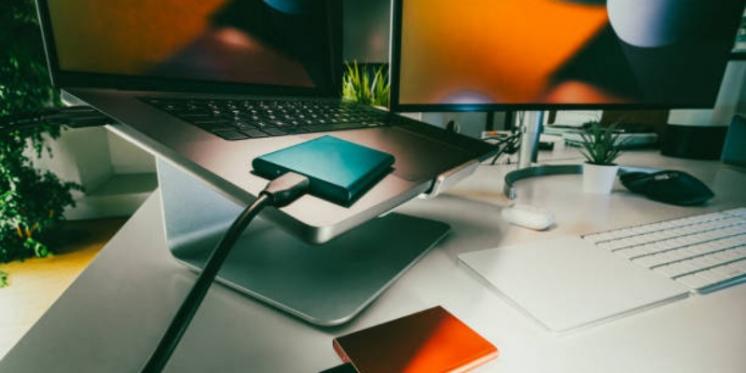How To Select The Best External Hard Drive For Backups
Losing that vital document can feel like you've lost a little piece of life. You should have a backup plan, whether family photos or work documents, personal projects or productivity. External hard drives make it easy to keep data safe. But how do you know which one is the right one? This guide dissects the essentials of picking a drive for backups.
Storage Capacity: How Much Space Do You Need?
The first step is to determine how much storage space you require. Consider the files you need to secure, whether you have hundreds of videos, thousands of photos, or just a few documents. Drives range from 500 gigabytes (GB) to 20 terabytes (TB). A 1TB drive can store about 250,000 photos or 500 hours of HD video. If you regularly deal with big files such as video or game files, a 4TB or higher drive will serve you better.

A drive with a 1TB or 2TB capacity might suffice if you buy for modest needs. However, you should always select a drive with more space than you could use now. This leaves some space for new files and speeds up backups.
Speed: How Fast Can It Save Your Files?
Speed matters when backing up large amounts of data. Two main factors affect speed: the drive type (HDD or SSD) and the connection port.
HDD vs. SSD
Hard Disk Drives (HDDs) use spinning disks to store data. They are slower but cheaper per gigabyte. Solid-state Drives (SSDs) have no moving parts and are much faster. They also cost more. An SSD is better for quick backups of large files. For long-term storage of less-used files, an HDD might be enough.
Connection Ports
Most drives use USB ports. Newer versions like USB 3.2 and USB-C are faster than older USB 2.0. Thunderbolt ports are even quicker but cost more. If your computer has a USB-C port, look for a drive with the same. This ensures the fastest transfer speeds.
For example, a drive with USB 3.2 can back up a 4K movie in seconds, while a slower drive might take minutes.
Portability: Can You Take It With You?
Size and weight matter if you carry your drive in a bag or pocket. Portable drives are small and light. They often connect via USB and don't need a separate power cable. Desktop drives are bigger and heavier and usually stay in one place. They offer more storage and speed, but aren't meant for travel.
For travellers, look for drives that are shock-resistant and compact. Some models are designed to survive drops or rough handling. If you'll use the drive at home and work, a desktop model with high speed and large capacity is a good pick.
Durability: Will It Survive Accidents?
No one plans for a drive to break, but accidents happen. Durability features can protect your data.
Shock Resistance
Drives with rubber coatings or reinforced casings handle drops better. This is key for portable drives.
Water and Dust Resistance
Some drives are rated for water or dust resistance. These are useful for outdoor work or harsh environments.
Temperature Tolerance
Extreme heat or cold can damage drives. Models designed for harsh conditions can handle wider temperature ranges.
SSDs are naturally more durable than HDDs because they have no moving parts. If you need ruggedness, an SSD is a safer bet.

Compatibility: Will It Work With Your Devices?
Not all drives work with every computer. Check the connection type and operating system support.
Connection Types
Most drives use USB-A or USB-C ports. Newer laptops often have USB-C, but older devices might only have USB-A. Some drives come with multiple cables or adapters.
Operating Systems
Some drives are pre-formatted for Windows or Mac. If you use both, look for a drive that works with both systems. You should reformat it, which erases data.
Cloud Integration
A few drives offer cloud backup services. These add an extra layer of protection by storing copies online. They're helpful for critical files but require an internet connection.
Price: How Much Should You Spend?
Budget is always a concern. Drives range from $40 for a basic 1TB HDD to $300 or more for a high-speed 4TB SSD.
Value Over Cost
Cheaper drives might save money now, but could fail sooner. Investing in a reliable drive avoids replacing it later.
Warranty and Support
More extended warranties (3–5 years) show confidence in quality. Brands with good customer support are worth considering.
Bundle Deals
Some drives come with software for backups, cloud storage, or encryption. These extras add value even if the base price is higher.
Extra Features: What Else To Consider
Encryption and Security
Some drives have built-in encryption to protect sensitive data. This is useful for businesses or personal files you don’t want stolen.
Noise and Heat
HDDs can make clicking sounds and get warm. SSDs are silent and cooler. If noise bothers you, pick an SSD.
LED Indicators
Lights show when the drive is working. This helps spot issues like failed backups.
Expandability
If you need more storage later, look for drives that let you add another drive or use RAID setups (combining multiple drives for speed or redundancy).
Real-World Testing: What Experts Recommend
Experts test drives for speed, reliability, and ease of use. Based on their findings:
Best Overall: Drives that balance speed, storage, and price. Look for USB 3.2 or Thunderbolt ports.
Best for Travel: Small, rugged SSDs with shock resistance.
Best for Large Backups: Desktop HDDs with 8TB or more storage.
Best for Speed: SSDs with Thunderbolt connections for lightning-fast transfers.
Common Mistakes To Avoid
Underestimating Storage Needs
Buying a drive that’s too small leads to frequent upgrades. Start with more space than you think you’ll need.
Ignoring Speed
Slow drives make backups tedious. Prioritise speed if you handle large files regularly.
Skipping Durability
A fragile drive can fail easily. Even if you don’t travel, drops or spills can happen.
Overlooking Compatibility
A drive that doesn’t work with your computer is useless. Double-check connection types and OS support.
Forgetting About Software
Good backup software simplifies the process. Drives with user-friendly apps save time and reduce errors.

How To Use Your Drive For Backups
Set a Schedule
Automate backups to avoid forgetting. Most drives have software to schedule daily, weekly, or monthly backups.
Keep It Separate
Store a backup drive in a different location from your primary device. This protects against theft, fire, or disasters.
Test Regularly
Check that backups work by restoring a file occasionally. This ensures the drive is functioning correctly.
Update as Needed
Replace old drives every few years. Technology changes, and older drives can become unreliable.
Putting It All Together
Choosing the best external hard drive for backups depends on balancing storage, speed, durability, and cost. Start by assessing your needs: how much data you have, how often you back up, and where you'll use the drive. Prioritise speed and durability if you travel or work with large files. For home use, focus on storage capacity and reliability. Always read reviews and compare models before buying. With the right drive, backing up your data becomes a simple, worry-free task.
Considering these factors, anyone can find a drive that fits their lifestyle and protects their precious files. The goal is to make backups easy, fast, and dependable, so you can focus on creating, working, and enjoying life without fear of losing what matters most.
Key Takeaways
Storage Capacity: Choose a drive with more space than you currently need.
Speed: Opt for SSDs and USB 3.2 or Thunderbolt ports for faster backups.
Portability: Pick a compact, shock-resistant drive for travel.
Durability: Look for rugged designs and SSDs for better protection.
Compatibility: Ensure the drive works with your computer’s ports and OS.
Price: Balanced cost with reliability and features like encryption.
Software: Use drives with easy-to-use backup apps for automation.
Finding the perfect drive isn’t about chasing the latest tech or the cheapest option. It’s about matching the drive’s features to your unique needs. With careful consideration, anyone can build a backup system that keeps their digital life secure.